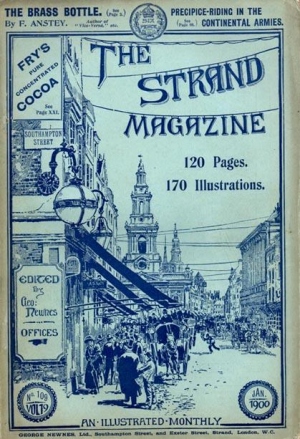Birthday Reviews: F. Anstey’s “The Adventure of the Snowing Globe”

F. Anstey was born Thomas Anstey Guthrie on August 8, 1856. He began using the pseudonym F. Anstey after an editor included a typo in his byline, replacing his first initial with an F. He published under both the F. Anstey name and his own name. He died on March 10, 1934.
Trained as a lawyer, Anstey frequently used his legal background in his books and novels, most of which were humorous. He was a frequent contributor to Punch. In addition to fiction, he also produced plays. Over the years, many of his stories have been turned into films, most recently the 1988 film Vice Versa, starring Judge Reinhold and Fred Savage, based on his 1882 book of the same title.
“The Adventure of the Snowing Globe” was originally published in the December 1905 issue of The Strand Magazine, edited by George Newnes. The following year, Anstey included the story in his collection Salted Almonds. In 1996, Peter Haining chose the story for his anthology The Wizards of Odd: Comic Tales of Fantasy, which has been translated, along with the story, into German. Mike Ashley used the story in his 2012 anthology Dreams and Wonders: Stories from the Dawn of Modern Fantasy. In 2013, the story was translated into Russian for inclusion in an anthology.
Anstey’s “The Adventure of the Snowing Globe” is almost a proof of the adage that to a man with a hammer every problem looks like a nail. Anstey’s narrator is, like Anstey, a lawyer. When he is magically transported into a snowglobe where a princess is held captive in a castle by her evil uncle, who has set a dragon to guard her, Anstey’s character resorts to legal means to free her, thinking of what motions he can file with the court, down to the level of naming the laws that he would bring to bear.
The princess, of course, understands the situation better than the attorney, but she can only conceive of a knight rescuing her and is tied into the paradigm as much as the narrator is tied to his legalistic one. The big difference, of course, being that the princess understands life within the snowglobe kingdom much better than the narrator does.
Anstey builds a divide between the princess and the lawyer by providing them with very different speech patterns. Both speak formally, but the princess and her seneschal speak in an archaic manner, while the lawyer speaks in an Edwardian manner, as if he were addressing a judge.
The lawyer has two tasks to perform to rescue the princess. He must slay the dragon (or otherwise neutralize it), and defeat the princess’s evil sorcerer uncle, who is due to arrive at the castle at any moment. Unfortunately, the lawyer only accomplishes one of these tasks before he is pulled back to his own world, where he questions the validity of his own experiences, giving the story an unfinished feel.
Reprint reviewed in its the anthology The Wizards of Odd, edited by Peter Haining, Legend, 1997.
 Steven H Silver is a sixteen-time Hugo Award nominee and was the publisher of the Hugo-nominated fanzine Argentus as well as the editor and publisher of ISFiC Press for 8 years. He has also edited books for DAW and NESFA Press. He began publishing short fiction in 2008 and his most recently published story is “Doing Business at Hodputt’s Emporium” in Galaxy’s Edge. Steven has chaired the first Midwest Construction, Windycon three times, and the SFWA Nebula Conference 6 times, as well as serving as the Event Coordinator for SFWA. He was programming chair for Chicon 2000 and Vice Chair of Chicon 7. He has been the news editor for SF Site since 2002.
Steven H Silver is a sixteen-time Hugo Award nominee and was the publisher of the Hugo-nominated fanzine Argentus as well as the editor and publisher of ISFiC Press for 8 years. He has also edited books for DAW and NESFA Press. He began publishing short fiction in 2008 and his most recently published story is “Doing Business at Hodputt’s Emporium” in Galaxy’s Edge. Steven has chaired the first Midwest Construction, Windycon three times, and the SFWA Nebula Conference 6 times, as well as serving as the Event Coordinator for SFWA. He was programming chair for Chicon 2000 and Vice Chair of Chicon 7. He has been the news editor for SF Site since 2002.